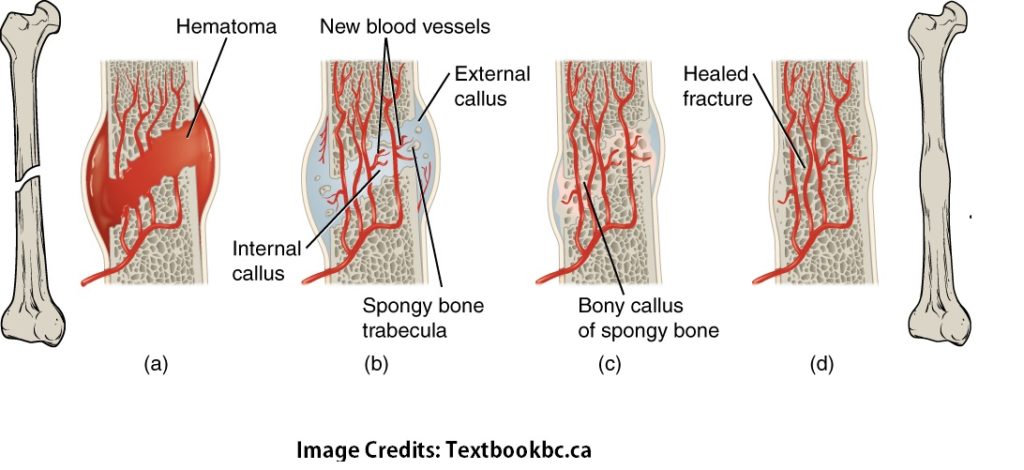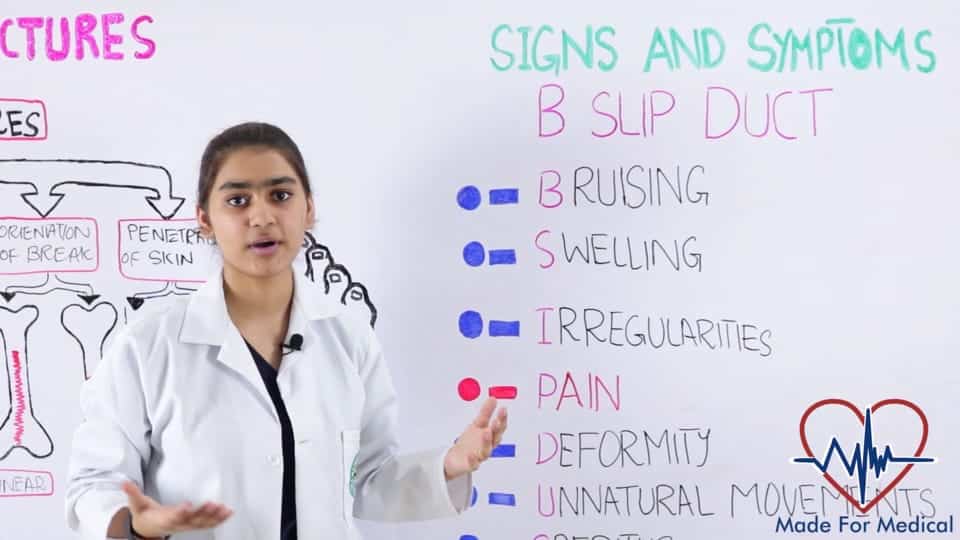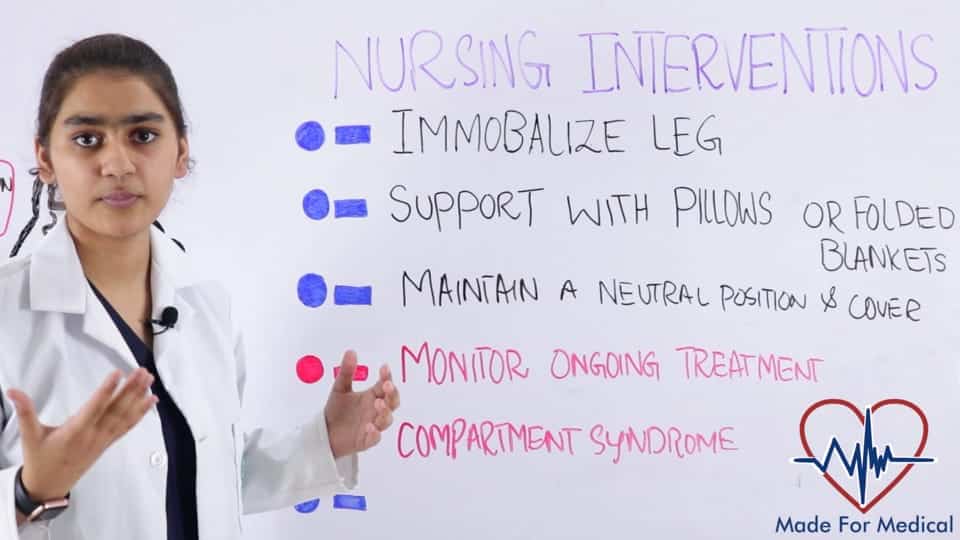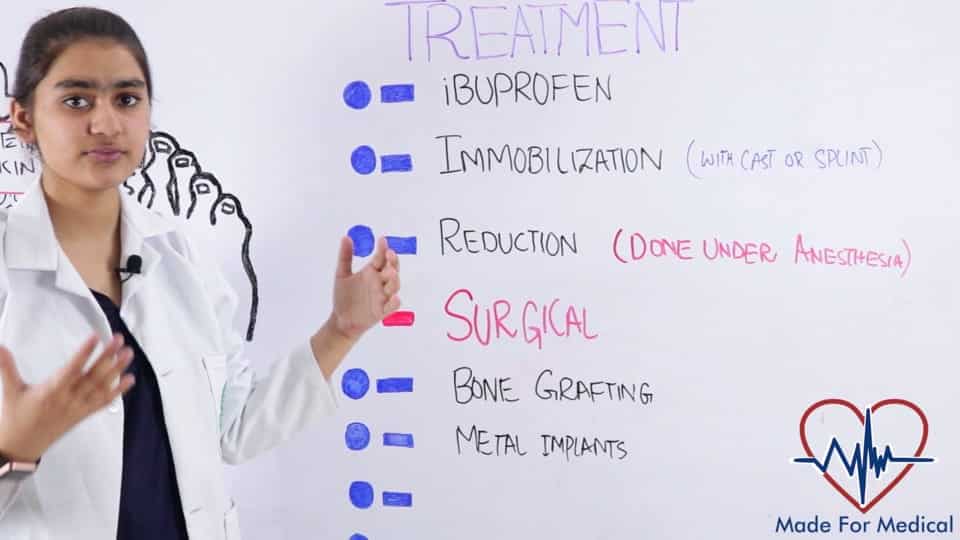Bone Fracture
First, let’s talk about what is a bone fracture? It is a medical condition where the continuity of the bone is broken. But what causes a bone fracture to occur? So number one is the trauma. A fall, a motor vehicle accident, or a tackle during a football game can all result in fractures. Or maybe due to Osteoporosis, that weakens bones and makes them more likely to break. Another thing is the Overuse. Repetitive motion can tire muscles and place more force on bone and this can result in stress fractures. Stress fractures are more common in athletes.
Watch this awesome video by Madeformedical.com to understand this topic completely.
Now let’s talk about the types of bone fractures. The bone fractures itself can be categorized into four parts.
- Either by the position of bone ends after the fracture
- Non-Displaced
- Displaced Fractures
- Or can be classified by the orientation of the break
- Vertical Fracture
- Horizontal Fracture
- Can be classified by the completeness of the fracture
- Complete Fracture
- Incomplete Fracture
- Or whether the bone ends penetrate the skin or not.
- Simple Fracture
- Compound Fracture
Now let’s talk about how a bone heals after it’s fractured, or how the fracture repairs itself. So here is a typical long bone in the diagram, and contains a periosteum that wraps around the bone. This stage represents the events right after the fracture has occurred. And we have blood vessels here and the blood is accumulated after a fracture.

However a few minutes after the fracture, the next phase begins called hematoma formation and is characterized by the formation of swelling, pain, and blood accumulates at the site of fracture as well.
After a few days, the bone will go to the next stage called fibrocartilaginous callus formation. So the blood vessels start growing and new blood vessels start forming, and a meshwork from granulated tissue forms a callus and also we have the formation of callus outside the fracture.
So the granulation tissue fills in the gap where the fracture is and rejoins the fractured bones together. Then after a few weeks, the bone enters the next phase called the bony callus formation phase, and it is when the previously formed soft callus becomes the bony callus, so the soft callus converts to the bony callus in this stage. And finally, after several months, the bony callus remodels to become strong new bone, where the healing occurs. So the previously fractured bone is now completely healed after the four stages.
Signs and Symptoms of Bone Fracture

To memorize signs and symptoms of bone fracture, just remember the word B SLIP DUCT. So B for bruising along with Swelling, irregularities, and pain. just like as we discussed earlier, a patient with fractured bone will have bruising, swelling, irregularities, and pain at the site of fracture. So D is for a deformity that depends upon the type of fracture.
U means unnatural movements, and it’s because the bone is broken and cannot provide support to the skeleton anymore, hence the movements of that limb or part of the body will be limited and painful. C is for crepitus and it is actually a crackling sound and is due to bone fragments rubbing together whereas T is for tenderness.
Nursing Interventions of Bone Fracture

Now, what are you gonna do for this patient who had a bone fracture? Suppose a patient comes to you with a broken leg, so, first of all, make sure they are stable, and immobilize that fractured leg.
Immobilization restricts motion to allow the injured area to heal. It can help reduce pain, swelling, and muscle spasms. In some cases, splints and casts are applied that repair bones, tendons, or ligaments. This allows for protection and proper alignment early in the healing process.
Support fracture site with pillows or folded blankets. Maintain a neutral position of the affected part with sandbags, splints, trochanter roll, or footboard. Cover the site with a sterile dressing if the fracture is open or compound. Because they are at risk of getting infections for example osteomyelitis. Closely monitor the ongoing treatment by the physician, like how effective these pain medications are working and also because we wanna catch compartment syndrome early.
Compartment syndrome is a painful condition that occurs when the pressure within the muscles builds to dangerous levels. This pressure can decrease blood flow, which prevents nourishment and oxygen from reaching nerve and muscle cells.
Treatment of Bone Fractures

Now let’s look at what treatment options we have for a patient with a fractured bone. In arm fractures in children, ibuprofen is as effective as a combination of acetaminophen and codeine.
Immobilization
since bone healing is a natural process that fracture treatment aims to ensure the best possible function of the injured part after healing. Bone fractures typically are treated by restoring the fractured pieces of bone to their natural positions, and maintaining those positions while the bone heals.
Aligning
Often, aligning the bone, called reduction is needed and it is done under anesthesia. This process is extremely painful without anesthesia, about as painful as breaking the bone itself. To this end, a fractured limb usually is immobilized with a plaster or fiberglass cast or splint that holds the bones in position and immobilizes the joints above and below the fracture.
Surgical Treatment
usually, surgery is performed only if conservative treatment has failed, is very likely to fail, or likely to result in a poor functional outcome. Occasionally, bone grafting is used to treat a fracture as well. Sometimes bones are reinforced with metal. These implants must be designed and installed with care.
Medical Disclaimer: The information provided on this website (www.madeformedical.com) is only for educational purpose and is Copyrights Protected. While we tried hard to write quality articles but still, the articles and the information within them is not guaranteed to be free of factual errors or typos and hence may not be correct. You are advised to independently verify the claims in the articles and make your own conclusion.
